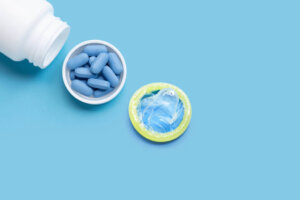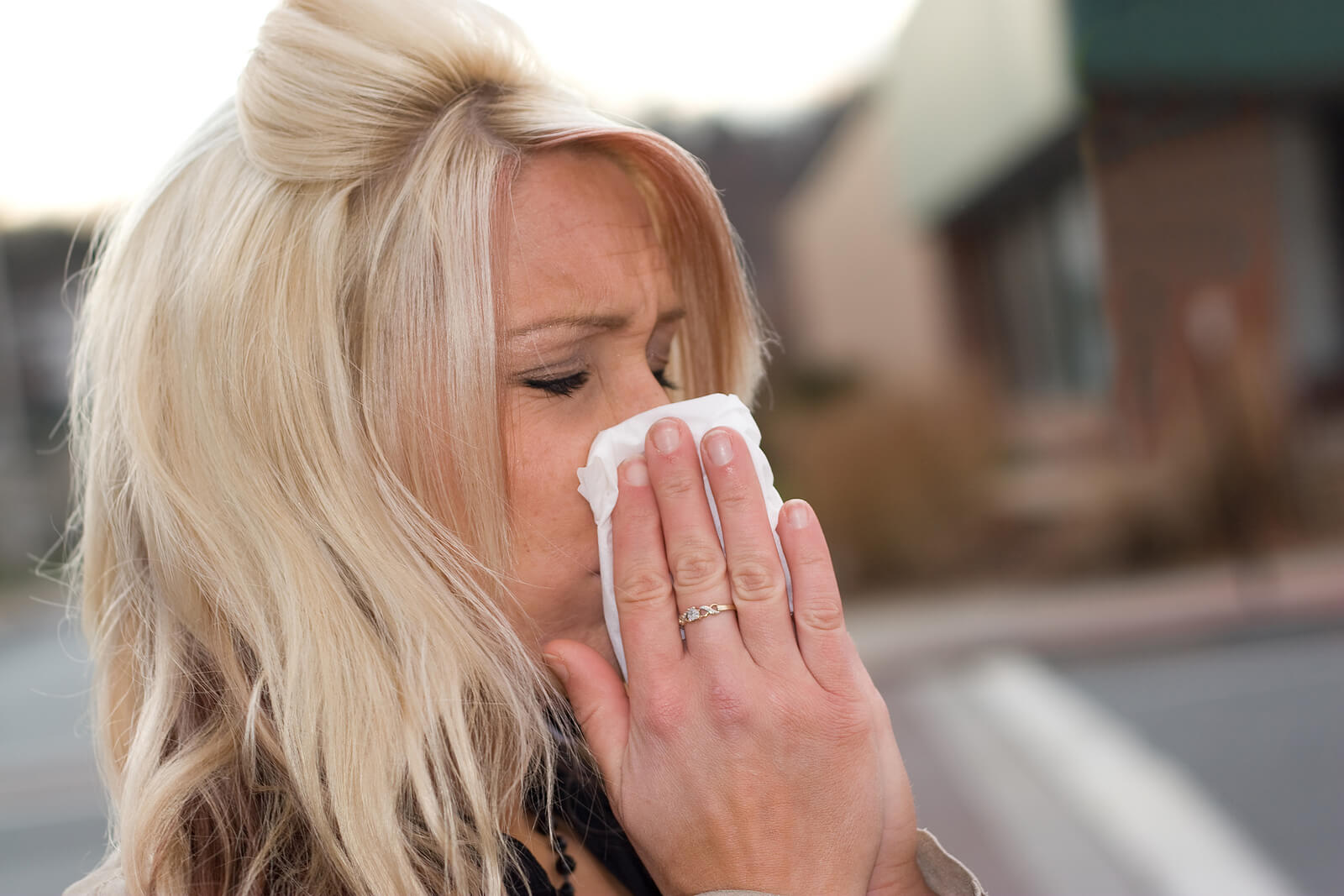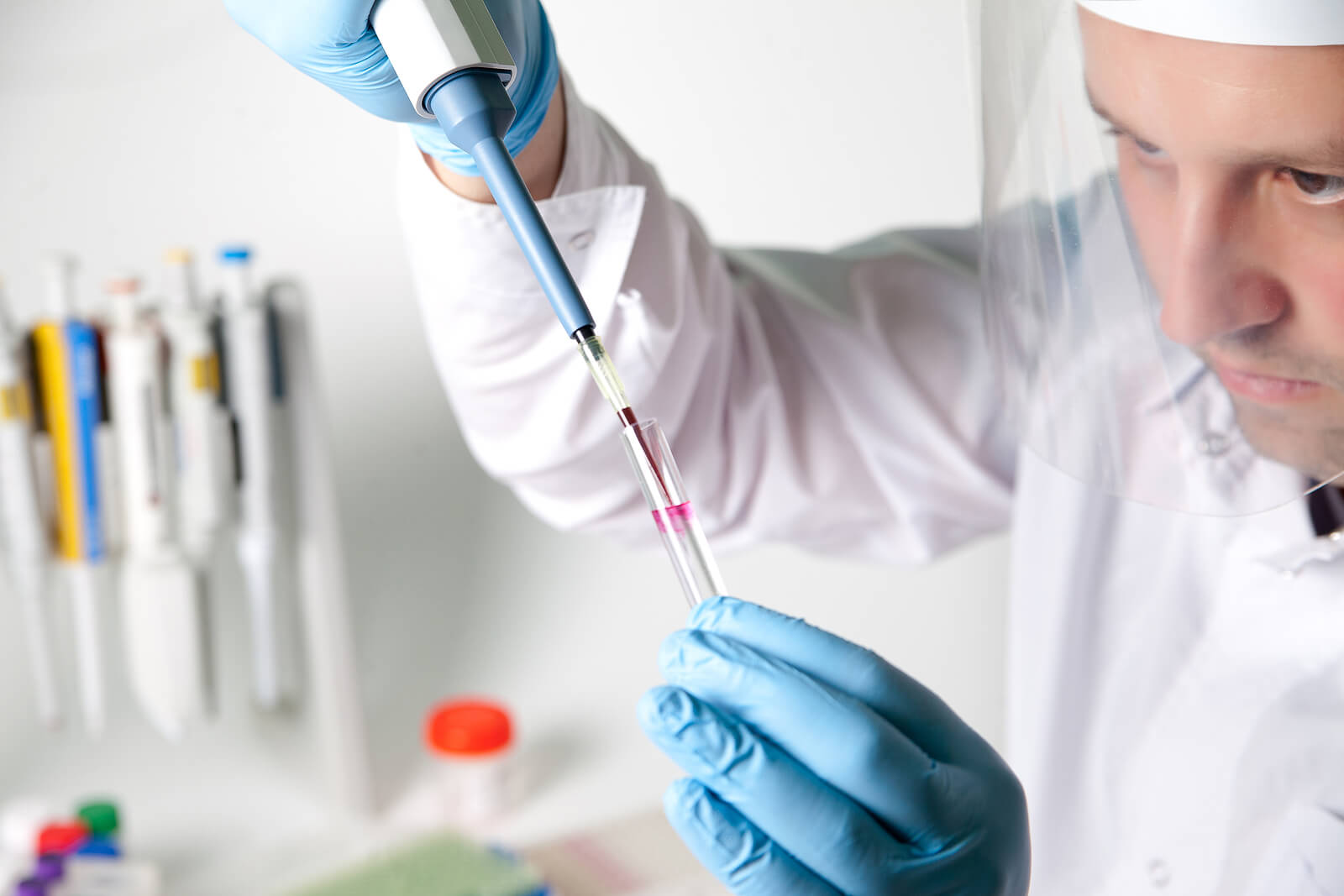What Is HIV?

The Human Immunodeficiency Virus (HIV) infects and destroys immune cells known as CD4 + T lymphocytes, weakening the body’s defenses to dangerous extremes. Generally, it’s transmitted through blood, breast milk, semen, and vaginal fluids.
Currently, there’s no cure for HIV, but, with treatment, it’s possible to control the disease and live a long life. Failure to do so can lead to Acquired Immunodeficiency Syndrome (AIDS), a point at which the immune system is so weak that it becomes unable to protect the body from diseases of any kind.
Symptoms of HIV
The human immunodeficiency virus is divided into 3 phases of infection: acute, chronic, and AIDS. During each of these stages, certain symptoms appear, which can vary and even be confused with those of other diseases. Let’s see more below.
Acute infection

It is the period in which the virus enters the body for the first time and the immune system reacts to protect it. During the acute infection phase, the virus spreads rapidly, so within 2 to 4 weeks, between 40% and 90% of people experience flu-like symptoms. These include the following:
- Fever
- Shaking chills
- Night sweats
- Throat pain
- Swollen lymph nodes
- Muscle pains
- Fatigue
- Acne
- Ulcers in the mouth
However, the duration of these symptoms can vary from a few days to several weeks. There are even cases where people don’t show any signs.
Chronic infection
This phase usually begins after the first month. Likewise, its duration can vary from years to decades, and people tend to have no symptoms.
However, even if there are no signs, the virus is active, so the cells are being attacked and, without treatment, the person can infect others.
AIDS
If you have HIV and don’t treat it, the virus will irreparably weaken the immune system and lead to AIDS. However, this usually takes several years. The symptoms of this phase include the following, sometimes caused by other infections or complications of the same disease:
- Recurring fever or night sweats
- Exhaustion
- Rapid weight loss
- Swollen lymph nodes in the armpits, groin, or neck
- Sores in the mouth, anus, and genitals
- Red, brown, pink, or purplish patches on or under the skin, inside the mouth, nose, or eyelids
- Diarrhea that lasts more than a week
Causes and risk factors
In general, the virus is transmitted through blood, semen, and other body fluids, so activities such as having unprotected sex and sharing needles to inject recreational drugs are among the main forms of infection.
During pregnancy, childbirth, or breastfeeding, the mother can also pass the virus to the baby. Similarly, having other sexually transmitted diseases (STDs) can increase the risk of contracting HIV.
Although the virus is transmitted through fluids that are frequently exchanged, it doesn’t thrive in some. HIV is transmitted through the following:
- Blood
- Pre-cum or pre-ejaculatory fluid
- Semen
- Vaginal fluids
- Rectal fluid
- Breast milk
However, it isn’t transmitted through:
- Saliva
- Sweat
- Tears
- Sharing food and drinks
- Use the same toilet, shower, or pool
Likewise, it’s necessary to take into account that for the infection to originate, the fluids must come into contact with:
- A mucous membrane such as the mouth, vagina, penis, or rectum
- Damaged tissue such as from an open wound
- The bloodstream (when injected directly)
Sexual risk factors
The Centers for Disease Control and Prevention (CDC) state that the risk of contracting HIV from having sex with an infected person varies according to the type of sexual activity:
- 1.38% risk in receptive anal sex
- 0.11% risk in insertive anal sex
- 0.08% risk in receptive vaginal sex
- 0.04% risk in insertive vaginal sex
- The risk in oral sex is low to negligible
If a person has a high viral load, they’re more likely to infect their sexual partner. Also, if the sexual partner is infected with another STD, the risk of getting HIV is significantly higher.
However, there are some measures that prevent the virus from being transmitted during sex. These include antiretroviral therapy, condom use, and pre-exposure prophylaxis (PrEP).
Other risk factors
There are other factors that increase the risk of contracting HIV. These include the following:
- Injecting drug use. The risk is estimated to be 0.63%.
- Blood transfusions. Considered the most direct way to contract the virus, the risk is 93%.
- Needle-stick injuries. They have a risk of around 0.23%.
- Contaminated tattoo or piercing equipment. Although it’s true that it’s a rare form of contagion, make sure that the establishment complies with strict hygiene measures.
- Mother-to-child transmission. This can be during pregnancy, childbirth, or breastfeeding.
HIV diagnosis

Although there are several tests to detect HIV, the specialist is in charge of determining which is the most suitable for each case.
- Antigen and antibody tests. These are usually the most used and show positive results between 18 and 45 days after contracting the virus. These blood tests check for antibodies, proteins the body makes to fight infection, and antigens, substances that initiate the immune response.
- Antibody tests. This type of test is carried out between 23 and 90 days after contracting the infection, as it’s the period in which HIV antibodies can be found in the blood or saliva. Likewise, it doesn’t require prior preparation and the results are ready in 30 minutes or less.
- Nucleic acid test. Unlike the previous tests, this one is a bit more expensive and isn’t for everyone. It’s recommended for those who have early symptoms of the virus or have a risk factor. It also doesn’t look for antibodies, but for the virus that takes between 5 to 21 days to appear in the blood.
Is there a silent period for HIV?
Yes. Although the virus begins to spread in the body as soon as contagion occurs, most people develop detectable antibodies between 23 and 90 days later. This is why the time between exposure to the virus and the moment it becomes detectable is known as the silent period.
If you take a test during this period, the result is likely to be negative, but you can still transmit the disease to others. In that sense, even though the test is negative, it should be taken again in a few weeks or a couple of months, and you should be cautious when having sex.
HIV treatment
Once the diagnosis has been made, the doctor will recommend immediate treatment. This consists mainly of antiretroviral therapy, a combination of drugs that fight the spread of the virus, prevent the development of AIDS, and reduce the risk of transmission.
There are more than 25 approved antiretroviral therapy drugs and they’re usually grouped into 6 classes. In general, it recommended an initial framework 3 HIV drugs containing at least 2 of the major classes. This helps to prevent drug resistance from developing.
Likewise, there are medications that are combined with each other so that people take between 1 and 2 pills a day. However, it will be the specialist who determines what the treatment will be.
Possible side effects
Antiretroviral therapy can cause headaches, dizziness, and nausea. However, these effects are usually temporary and disappear with time. Likewise, it generates slightly more serious complications such as inflammation of the mouth and tongue, and liver or kidney damage, among others. However, if these are very severe, it’s imperative to rethink medications.
Prevention
There’s still no cure for the virus, but there are ways to prevent the spread:
Practice safe sex
Among the most common forms of infection is anal or vaginal sex without a condom or other barrier contraceptives. While it’s true that the safest thing would be to avoid having sex, the risk could be reduced with certain precautions. Some of them include the following:
- Getting tested for HIV or other STDs
- Using condoms
- Taking antiretroviral therapy medications as directed by the specialist
Other prevention methods
You can also avoid contagion if you don’t share needles. If you have been exposed to the virus or have a higher probability of being exposed to it, it’s advisable to consult with a specialist about post-exposure prophylaxis (PEP) and pre-exposure prophylaxis (PrEP).
The Human Immunodeficiency Virus (HIV) infects and destroys immune cells known as CD4 + T lymphocytes, weakening the body’s defenses to dangerous extremes. Generally, it’s transmitted through blood, breast milk, semen, and vaginal fluids.
Currently, there’s no cure for HIV, but, with treatment, it’s possible to control the disease and live a long life. Failure to do so can lead to Acquired Immunodeficiency Syndrome (AIDS), a point at which the immune system is so weak that it becomes unable to protect the body from diseases of any kind.
Symptoms of HIV
The human immunodeficiency virus is divided into 3 phases of infection: acute, chronic, and AIDS. During each of these stages, certain symptoms appear, which can vary and even be confused with those of other diseases. Let’s see more below.
Acute infection

It is the period in which the virus enters the body for the first time and the immune system reacts to protect it. During the acute infection phase, the virus spreads rapidly, so within 2 to 4 weeks, between 40% and 90% of people experience flu-like symptoms. These include the following:
- Fever
- Shaking chills
- Night sweats
- Throat pain
- Swollen lymph nodes
- Muscle pains
- Fatigue
- Acne
- Ulcers in the mouth
However, the duration of these symptoms can vary from a few days to several weeks. There are even cases where people don’t show any signs.
Chronic infection
This phase usually begins after the first month. Likewise, its duration can vary from years to decades, and people tend to have no symptoms.
However, even if there are no signs, the virus is active, so the cells are being attacked and, without treatment, the person can infect others.
AIDS
If you have HIV and don’t treat it, the virus will irreparably weaken the immune system and lead to AIDS. However, this usually takes several years. The symptoms of this phase include the following, sometimes caused by other infections or complications of the same disease:
- Recurring fever or night sweats
- Exhaustion
- Rapid weight loss
- Swollen lymph nodes in the armpits, groin, or neck
- Sores in the mouth, anus, and genitals
- Red, brown, pink, or purplish patches on or under the skin, inside the mouth, nose, or eyelids
- Diarrhea that lasts more than a week
Causes and risk factors
In general, the virus is transmitted through blood, semen, and other body fluids, so activities such as having unprotected sex and sharing needles to inject recreational drugs are among the main forms of infection.
During pregnancy, childbirth, or breastfeeding, the mother can also pass the virus to the baby. Similarly, having other sexually transmitted diseases (STDs) can increase the risk of contracting HIV.
Although the virus is transmitted through fluids that are frequently exchanged, it doesn’t thrive in some. HIV is transmitted through the following:
- Blood
- Pre-cum or pre-ejaculatory fluid
- Semen
- Vaginal fluids
- Rectal fluid
- Breast milk
However, it isn’t transmitted through:
- Saliva
- Sweat
- Tears
- Sharing food and drinks
- Use the same toilet, shower, or pool
Likewise, it’s necessary to take into account that for the infection to originate, the fluids must come into contact with:
- A mucous membrane such as the mouth, vagina, penis, or rectum
- Damaged tissue such as from an open wound
- The bloodstream (when injected directly)
Sexual risk factors
The Centers for Disease Control and Prevention (CDC) state that the risk of contracting HIV from having sex with an infected person varies according to the type of sexual activity:
- 1.38% risk in receptive anal sex
- 0.11% risk in insertive anal sex
- 0.08% risk in receptive vaginal sex
- 0.04% risk in insertive vaginal sex
- The risk in oral sex is low to negligible
If a person has a high viral load, they’re more likely to infect their sexual partner. Also, if the sexual partner is infected with another STD, the risk of getting HIV is significantly higher.
However, there are some measures that prevent the virus from being transmitted during sex. These include antiretroviral therapy, condom use, and pre-exposure prophylaxis (PrEP).
Other risk factors
There are other factors that increase the risk of contracting HIV. These include the following:
- Injecting drug use. The risk is estimated to be 0.63%.
- Blood transfusions. Considered the most direct way to contract the virus, the risk is 93%.
- Needle-stick injuries. They have a risk of around 0.23%.
- Contaminated tattoo or piercing equipment. Although it’s true that it’s a rare form of contagion, make sure that the establishment complies with strict hygiene measures.
- Mother-to-child transmission. This can be during pregnancy, childbirth, or breastfeeding.
HIV diagnosis

Although there are several tests to detect HIV, the specialist is in charge of determining which is the most suitable for each case.
- Antigen and antibody tests. These are usually the most used and show positive results between 18 and 45 days after contracting the virus. These blood tests check for antibodies, proteins the body makes to fight infection, and antigens, substances that initiate the immune response.
- Antibody tests. This type of test is carried out between 23 and 90 days after contracting the infection, as it’s the period in which HIV antibodies can be found in the blood or saliva. Likewise, it doesn’t require prior preparation and the results are ready in 30 minutes or less.
- Nucleic acid test. Unlike the previous tests, this one is a bit more expensive and isn’t for everyone. It’s recommended for those who have early symptoms of the virus or have a risk factor. It also doesn’t look for antibodies, but for the virus that takes between 5 to 21 days to appear in the blood.
Is there a silent period for HIV?
Yes. Although the virus begins to spread in the body as soon as contagion occurs, most people develop detectable antibodies between 23 and 90 days later. This is why the time between exposure to the virus and the moment it becomes detectable is known as the silent period.
If you take a test during this period, the result is likely to be negative, but you can still transmit the disease to others. In that sense, even though the test is negative, it should be taken again in a few weeks or a couple of months, and you should be cautious when having sex.
HIV treatment
Once the diagnosis has been made, the doctor will recommend immediate treatment. This consists mainly of antiretroviral therapy, a combination of drugs that fight the spread of the virus, prevent the development of AIDS, and reduce the risk of transmission.
There are more than 25 approved antiretroviral therapy drugs and they’re usually grouped into 6 classes. In general, it recommended an initial framework 3 HIV drugs containing at least 2 of the major classes. This helps to prevent drug resistance from developing.
Likewise, there are medications that are combined with each other so that people take between 1 and 2 pills a day. However, it will be the specialist who determines what the treatment will be.
Possible side effects
Antiretroviral therapy can cause headaches, dizziness, and nausea. However, these effects are usually temporary and disappear with time. Likewise, it generates slightly more serious complications such as inflammation of the mouth and tongue, and liver or kidney damage, among others. However, if these are very severe, it’s imperative to rethink medications.
Prevention
There’s still no cure for the virus, but there are ways to prevent the spread:
Practice safe sex
Among the most common forms of infection is anal or vaginal sex without a condom or other barrier contraceptives. While it’s true that the safest thing would be to avoid having sex, the risk could be reduced with certain precautions. Some of them include the following:
- Getting tested for HIV or other STDs
- Using condoms
- Taking antiretroviral therapy medications as directed by the specialist
Other prevention methods
You can also avoid contagion if you don’t share needles. If you have been exposed to the virus or have a higher probability of being exposed to it, it’s advisable to consult with a specialist about post-exposure prophylaxis (PEP) and pre-exposure prophylaxis (PrEP).
- HIV.gov [Updated 2020 Jul 01]. Symptoms of HIV. Available from: https://www.hiv.gov/hiv-basics/overview/about-hiv-and-aids/symptoms-of-hiv
- Volmink, J., & Marais, B. (2008). HIV: mother-to-child transmission. BMJ clinical evidence, 2008, 0909.
- Centers for Disease Control and Prevention [Updated 2020 Oct 28]. HIV – HIV Risk Behaviors. Available from: https://www.cdc.gov/hiv/risk/estimates/riskbehaviors.html
- Spinner, C. D., Boesecke, C., Zink, A., Jessen, H., Stellbrink, H. J., Rockstroh, J. K., & Esser, S. (2016). HIV pre-exposure prophylaxis (PrEP): a review of current knowledge of oral systemic HIV PrEP in humans. Infection, 44(2), 151–158. https://doi.org/10.1007/s15010-015-0850-2
- HIVinfo [Updated 2020 Sep 24]. HIV Treatment – What to Start: Choosing an HIV Regimen. Available from: https://hivinfo.nih.gov/understanding-hiv/fact-sheets/what-start-choosing-hiv-regimen
- Siedner, M. J., Tumarkin, E., & Bogoch, I. I. (2018). HIV post-exposure prophylaxis (PEP). BMJ (Clinical research ed.), 363, k4928. https://doi.org/10.1136/bmj.k4928
Este texto se ofrece únicamente con propósitos informativos y no reemplaza la consulta con un profesional. Ante dudas, consulta a tu especialista.







